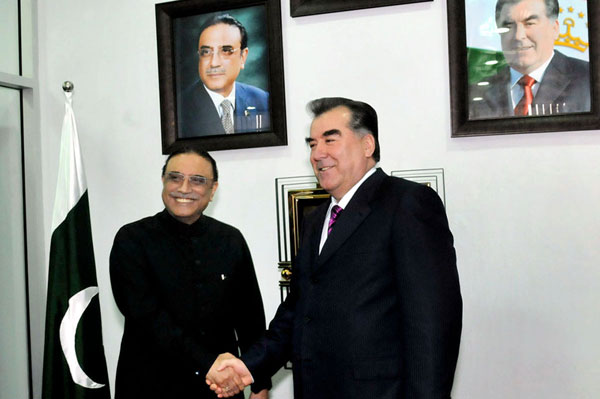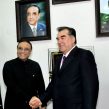
CASA-1000 Opens Doors for Increased Cooperation Between Tajikistan and Pakistan
Publication: Eurasia Daily Monitor Volume: 9 Issue: 98
By:

On May 16-17, members of the Inter-Governmental Council (IGC) met in Dubai to sign the financing agreements for the CASA-1000 energy project (Khovar, May 18). Delegations from the four principal countries, Pakistan, Afghanistan, Tajikistan and Kyrgyzstan, as well as representatives from investor countries, the World Bank, USAID, Islamic Development Bank, Asian Development Bank, International Finance Corporation (IFC) and the Arab Bank built upon the framework agreed to this March at the RECCA-V summit in Dushanbe, Tajikistan. The ambitious plan calls for the establishment of 750 kilometers of electrical transmission lines between Tajikistan and Kyrgyzstan to Afghanistan and Pakistan. Russia, the lead investor in the project, has pledged $500 million of the estimated $873-million total cost (Pak Tribune, May 18; also see EDM, April 4).
These recent developments come on the heels of a series of meetings this March in which Tajikistani President Emomali Rahmon discussed bilateral economic cooperation with his Pakistani counterpart Asif Ali Zardari. During this visit, the two leaders also cut the ribbon at the grand opening of the first branch of the National Bank of Pakistan in Tajikistan. The initial Pakistani investment into the bank is 50 million Somoni (approximately $10.5 million) and is intended to spur bilateral trade between the two countries (https://tajik.irib.ir/tajiki/mobile/2/3574.html). Since then, other high level commercial and diplomatic meetings between Tajikistani and Pakistani officials have taken place. These include a May 7 visit in Dushanbe between Sharif Said, head of Tajikistan’s Chamber of Commerce and Industry, and a Pakistan trade delegation; as well as a May 11 meeting in Karachi between Tajikistan’s Ambassador Dr. Zubaydullo N. Zubaydov and Irshad Qasim, Honorary Consul General of Tajikistan in Karachi, with the Trade Development Authority of Pakistan. (Khovar, May 7; Ozodi, May 11; also see EDM, January 31, 2011).
However, developments have not been limited to the trade and energy sectors. Last week, Tajikistani and Pakistani officials also announced new air service between Dushanbe and Islamabad, scheduled to begin in June. Initially “Tajik Air” will operate the flights twice weekly and it is expected that new routes servicing Dushanbe-Karachi and Dushanbe-Lahore will be added later, with Pakistan International Airlines operating the latter (Ozodi, www.thenews.com.pk, May 16). The new flights will be opening at a time when the price of airplane tickets in Tajikistan have risen by as much as 20 percent due to a spike in the cost of fuel and allegations of uncompetitive business practices and market manipulation (Ozodi, May 14).
In addition to the new routes, Tajikistan has been given permission to open a consulate in Karachi where business and tourist visas will be issued. According Tajikistan’s Ambassador to Pakistan, Dr. Zubaydullo N. Zubaydov, Tajikistan is also in the early stages of establishing consulates in Lahore and Peshawar (Ozodi, May 16). While both countries seem eager to facilitate the flow of businessmen and tourists between them, in the past Tajikistan has been wary of its citizens travelling to Pakistan for religious education. In 2010, several hundred Tajik students studying at madrassas in Pakistan were among the nearly 1,000 religious students recalled home out of fear that they were being radicalized (Khovar, January 6). Additionally, several alleged Tajik fighters have been apprehended on Pakistani soil and extradited to Tajikistan (see EDM, May 8).
While joint regional energy projects such as CASA-1000 have been a long time in the making, the idea of establishing direct flights between the countries is quite new. Both sides have hoped for an overland route to connect their respective markets. The proposed route is to link the Chinese-built roads in Badakhshan province in Tajikistan to the Karakoram Highway in Pakistan via Afghanistan’s Wakhan Corridor; however, the mountainous terrain and poor quality roads make this route problematic (see EDM, November 9, 2011). Likewise this January, Pakistan offered Tajikistan the use of its deep water port in Gwadar. However, given the difficulty of the overland connection and the dearth of Tajikistan’s exports it seems unlikely that the Central Asian republic’s use of the Pakistani port will have any impact on the economies of either country in the near future.
While most analysts view Pakistan’s recent courtship of Tajikistan merely through the lens of hydro-electricity, others maintain that Pakistan’s interests also relate to its attempts to expand its strategic depth in Central Asia. With US and NATO forces scheduled to withdraw from Afghanistan in 2014, neighboring countries are preparing for various post-ISAF contingencies. Tajikistan’s chief fear is of Islamic radicalism and domestic instability that could lead to the return of the kind of violence that plagued the country in the 1990s. In the event of deteriorating violence in Afghanistan following a withdrawal of NATO troops, Tajikistan will most likely look to elements of the former Northern Alliance (most of them ethnically Tajik) to serve as a buffer zone between Tajikistan’s border and the Taliban. Given that Pakistan will require a degree of stability to import electricity via the CASA-1000 and the CASAREM grid, this sort of economic entanglement may spur Pakistan to leverage what influence it has over the Taliban into maintaining a degree of peace in northern Afghanistan. In the past, Tajikistan has garnered good will from Islamabad by rebuffing Indian overtures to install itself in the Soviet-era Ayni airbase in Tajikistan even after New Delhi invested $70 million to refurbish it (see EDM, January 31). While Tajikistan’s refusal to lease the airfield is most likely more attributable to Russian pressure, it had the side effect of garnering diplomatic capital with Islamabad and facilitated the increase in cooperation between the two countries, adding a new layer of complexity to Tajikistan’s multi-vector foreign policy.




